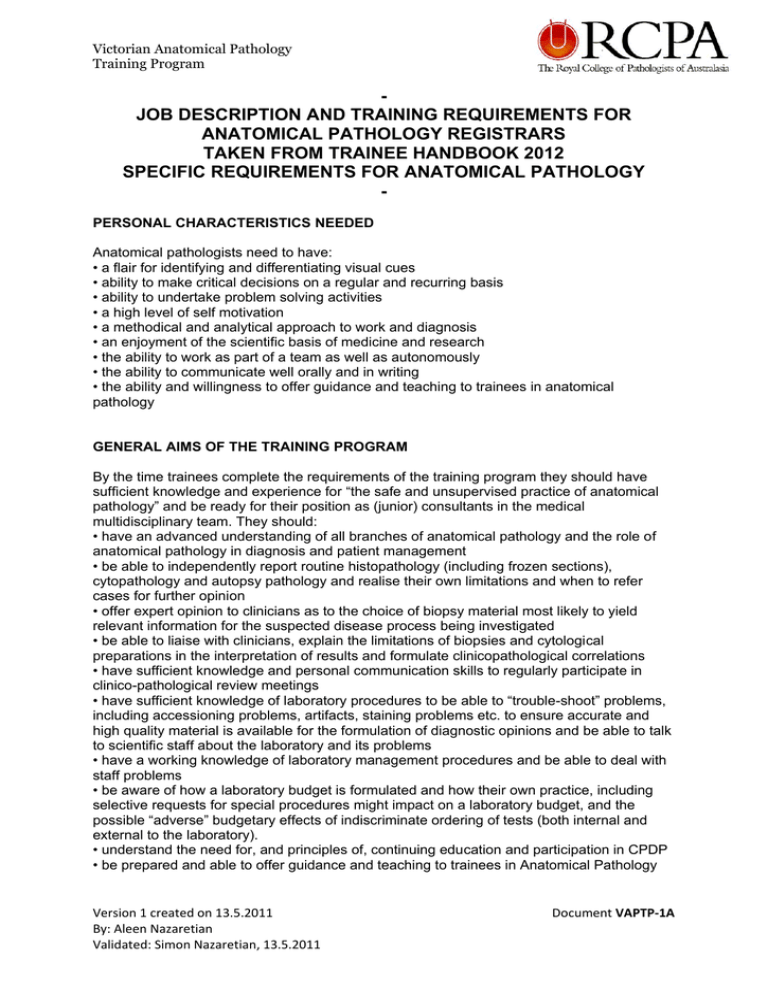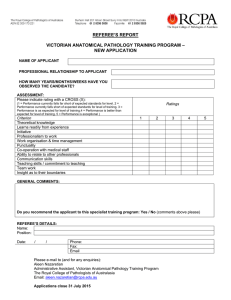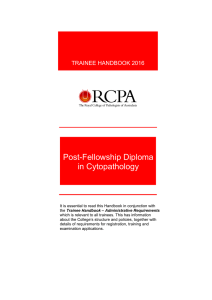- JOB DESCRIPTION AND TRAINING REQUIREMENTS FOR ANATOMICAL PATHOLOGY REGISTRARS
advertisement

Victorian Anatomical Pathology Training Program JOB DESCRIPTION AND TRAINING REQUIREMENTS FOR ANATOMICAL PATHOLOGY REGISTRARS TAKEN FROM TRAINEE HANDBOOK 2012 SPECIFIC REQUIREMENTS FOR ANATOMICAL PATHOLOGY PERSONAL CHARACTERISTICS NEEDED Anatomical pathologists need to have: • a flair for identifying and differentiating visual cues • ability to make critical decisions on a regular and recurring basis • ability to undertake problem solving activities • a high level of self motivation • a methodical and analytical approach to work and diagnosis • an enjoyment of the scientific basis of medicine and research • the ability to work as part of a team as well as autonomously • the ability to communicate well orally and in writing • the ability and willingness to offer guidance and teaching to trainees in anatomical pathology GENERAL AIMS OF THE TRAINING PROGRAM By the time trainees complete the requirements of the training program they should have sufficient knowledge and experience for “the safe and unsupervised practice of anatomical pathology” and be ready for their position as (junior) consultants in the medical multidisciplinary team. They should: • have an advanced understanding of all branches of anatomical pathology and the role of anatomical pathology in diagnosis and patient management • be able to independently report routine histopathology (including frozen sections), cytopathology and autopsy pathology and realise their own limitations and when to refer cases for further opinion • offer expert opinion to clinicians as to the choice of biopsy material most likely to yield relevant information for the suspected disease process being investigated • be able to liaise with clinicians, explain the limitations of biopsies and cytological preparations in the interpretation of results and formulate clinicopathological correlations • have sufficient knowledge and personal communication skills to regularly participate in clinico-pathological review meetings • have sufficient knowledge of laboratory procedures to be able to “trouble-shoot” problems, including accessioning problems, artifacts, staining problems etc. to ensure accurate and high quality material is available for the formulation of diagnostic opinions and be able to talk to scientific staff about the laboratory and its problems • have a working knowledge of laboratory management procedures and be able to deal with staff problems • be aware of how a laboratory budget is formulated and how their own practice, including selective requests for special procedures might impact on a laboratory budget, and the possible “adverse” budgetary effects of indiscriminate ordering of tests (both internal and external to the laboratory). • understand the need for, and principles of, continuing education and participation in CPDP • be prepared and able to offer guidance and teaching to trainees in Anatomical Pathology Version 1 created on 13.5.2011 By: Aleen Nazaretian Validated: Simon Nazaretian, 13.5.2011 Document VAPTP-1A Victorian Anatomical Pathology Training Program These general aims of the training program relate to four general functions of anatomical pathologists, ie, • discipline specific functions as a medical specialist in the laboratory • functions as a manager in the laboratory • other professional functions of anatomical pathologists • generic processes employed by anatomical pathologists These functions are elaborated as specific training outcomes and activities in Section 2. TRAINING REQUIREMENTS To gain Fellowship as a specialist Anatomical Pathologist requires five (5) years of accredited training in the discipline, which includes surgical pathology, morbid anatomy and cytopathology. The training program must include a period in cytopathology equivalent to a minimum of three (3) months full time in a department, processing and reporting sufficient gynaecological and non-gynaecological cytopathology to ensure competence. Continued exposure to cytopathology must be ensured throughout the usual five years of training. Trainees and supervisors are to ensure that experience is gained in special areas that may not be available in the primary training laboratory, including exfoliative and fluid based cytology, fine needle aspiration cytology, coronial autopsies, neuropathology, gynaecological-obstetric pathology and neonatal-paediatric pathology. Knowledge of the specialised techniques of immunofluorescence microscopy, electron microscopy, immunohistochemistry and histochemistry is expected, sufficient to enable trainees to advise clinicians of the requirements and likely benefits of such techniques and to assist in result interpretation. Knowledge of the appropriate use of molecular testing as ancillary diagnostic and prognostic tools in anatomical pathology is also expected. RESEARCH STREAM Trainees may opt for a research stream but must demonstrate competence in all aspects of Anatomical Pathology to gain Fellowship. Trainees must apply to the Board of Censors as soon as possible after the Part I examination for approval of the project, laboratory and supervisor. The research must be considered relevant and significant enough to lead to a PhD or MD by thesis. Research trainees are required to undertake or be exempt from the Basic Pathological Sciences Examination and Part II examinations and to satisfy portfolio (work-place based assessment) requirements. All applications for exemptions must be submitted to the Registrar for consideration by the Board of Censors. At the Part II examination, the trainee may be tested orally on the thesis as well as being tested on gross and microscopic anatomical pathology. The Board of Censors will consider each case individually and inform applicants of the examination process Version 1 created on 13.5.2011 By: Aleen Nazaretian Validated: Simon Nazaretian, 13.5.2011 Document VAPTP-1A


